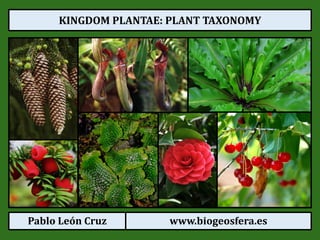
Kingdom Plantae - Plant taxonomy
- 1. Pablo León Cruz www.biogeosfera.es KINGDOM PLANTAE: PLANT TAXONOMY
- 2. The evolution of plants The plants that we know today emerged about 500 million years ago through the process of evolution. The most primitive plants inhabited aquatic environments and gradually colonized the terrestrial environment. For this to occur, it was necessary to develop new organs and tissues: Epidermal tissues to prevent dehydration. Supportive tissues to grow upright. Conductive tissues to transport substances. Flowers to produce pollen and promote fertilization.
- 3. The evolution of plants Algae: Aquatic organisms that lack differentiated tissues. Bryophytes: Very simple and small with epidermal tissue but no conductive or supporting tissues. Pteridophytes: Have epidermal and conductive tissues. They have roots, stems and leaves, but no flowers. Gymnosperms: Have epidermal, conductive and supporting tissues. Woody plants with inflorescence and naked seeds. Angiosperms: The largest group. They have epidermal, conductive and supportive tissues. They have flowers and fruits. Algaes Bryophytes Pteridophytes Gymnosperms Angiosperms
- 4. The evolution of plants
- 5. The evolution of plants Epidermal tissues Conductive tissues Supportive tissues Bryophytes Pteridophytes Gymnosperms Angiosperms
- 6. Bryophytes Characteristics of bryophytes Small plants with very simple structures. Non-vascular plants, that is, not having specialized organs for transporting water. Have false roots (rhizoids), false stems (cauloids) and false leaves (phyllodes). Only have epidermal tissue, but no conductive or supportive tissues. Don’t have flowers and breed by spores. Have alternating reproduction, with gametophyte and sporophyte. Live in the shade in very humid places. Grow on walls, tree trunks, rocks and on the ground. There are three types of bryophytes: mosses, liverworts and hornworts.
- 7. Bryophytes Parts of a moss Stalk Phyllodes Rhizoids Capsule Spores Cauloids gametophyte SporophyteGametophyte
- 8. Bryophytes
- 11. Pteridophytes Characteristics of pteridophytes Medium-sized plants. Vascular plants: have roots, stems and leaves. Mainly comprised of epidermal and conductive tissues. Their leaves are called fronds. They don’t have flowers and breed by spores. Alternating reproduction of gametophyte and sporophyte. Inhabit cool, humid and shaded terrestrial environments, although some species can live in dry environments. Grow on walls, tree trunks, rocks and on the ground. Originated in the Devonian period. During the Carboniferous period they formed large forests that gave rise to current coal deposits. There are three primary groups: Lycopods, ferns and horsetails.
- 12. Pteridophytes Parts of a fern Rhizome Roots Sorus Spores Frond
- 14. Pteridophytes Different types of ferns
- 15. Pteridophytes The pteridophyte forests of the Carboniferous period The Carboniferous plants formed huge swamp forests where a large number of pteridophytes grew. When they died, the plants sank down into the water, gradually decomposed and, when covered with several layers of soil and underneath great pressure for millions of years, they formed the coal deposits we know today.
- 16. Gymnosperms Characteristics of gymnosperms Medium to large-sized plants. Vascular plants: they have roots, stems and leaves. Have epidermal, conductive and supporting tissues. Possess unisexual inflorescence: male and female. Evergreens with needle-shaped leaves. Pollination is by anemophily (by wind). The seeds are not protected by a fruit (naked) and are found in the cone. The most well-known gymnosperms are conifers: pines, fir trees, cedars, cypresses, junipers… but there are also other gymnosperms such as gingkoes, yews and sago palms.
- 17. Gymnosperms The inflorescences of gymnosperms
- 18. Gymnosperms The inflorescences of gymnosperms
- 23. Gymnosperms Other gymnosperms you should know… Yew (Taxus baccata) Ginkgo (Ginkgo biloba) Sago palm (Cycas revoluta) Melinjo (Gnetum gnemon)
- 24. Angiosperms Characteristics of the angiosperms Very large, such as herbs, shrubs and trees. Vascular plants: they have roots, stems and leaves. Epidermal, conductive and structural tissues. Possess very striking flowers that are typically hermaphroditic. Pollination is usually zoogamous, especially by insects (entomophily). The seeds are protected by a fleshy or dried fruit. There are about 257,000 species, making them the largest group of plants. The diversity of angiosperms is much higher in tropical areas and decreases towards colder climates. They can be monocotyledonous (monocots) or dicotyledonous (dicots).
- 25. Angiosperms Monocotyledonous (Monocots) There is no primary root. The stems don’t have branches. The leaves do not have a petiole. The venation of the leaf is parallel. The conductive tissues are randomly distributed. The flower structures are usually in sets of three. The embryo emits a single cotyledon when it begins to grow. Examples: Palm trees, orchids, grasses, bulbous plants… Dicotyledonous (Dicots) They have a main branching root. The stems are typically branched. The leaves have a petiole. The venation of the leaves can be very varied. The conductive tissues are arranged in concentric rings. The flower structures are usually in sets of four or five. The embryo emits two cotyledons when it begins to grow. Examples: Trees (oak, olive, beech), shrubs (rose, camellia), legumes…
- 26. Angiosperms Comparing monocots and dicots
- 29. Angiosperms Angiosperms are found all over the world
- 30. Angiosperms Angiosperms are found all over the world
- 31. Angiosperms Angiosperms are found all over the world
- 32. Angiosperms Angiosperms are found all over the world